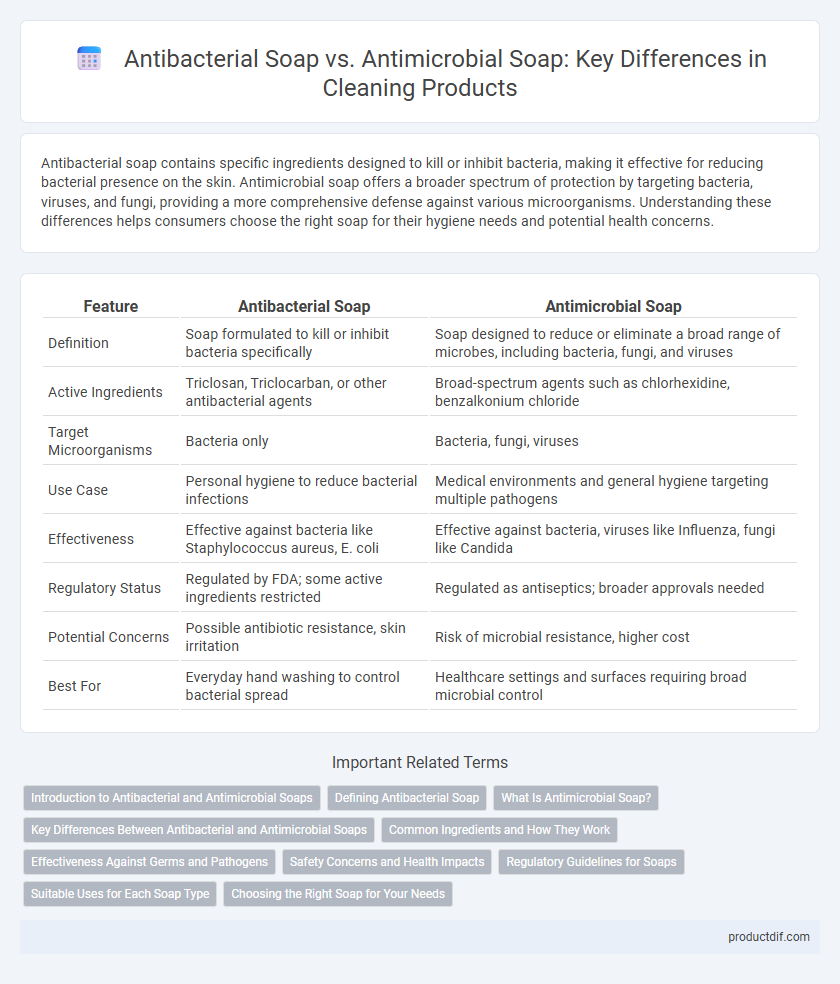Antibacterial soap contains specific ingredients designed to kill or inhibit bacteria, making it effective for reducing bacterial presence on the skin. Antimicrobial soap offers a broader spectrum of protection by targeting bacteria, viruses, and fungi, providing a more comprehensive defense against various microorganisms. Understanding these differences helps consumers choose the right soap for their hygiene needs and potential health concerns.
Table of Comparison
| Feature | Antibacterial Soap | Antimicrobial Soap |
|---|---|---|
| Definition | Soap formulated to kill or inhibit bacteria specifically | Soap designed to reduce or eliminate a broad range of microbes, including bacteria, fungi, and viruses |
| Active Ingredients | Triclosan, Triclocarban, or other antibacterial agents | Broad-spectrum agents such as chlorhexidine, benzalkonium chloride |
| Target Microorganisms | Bacteria only | Bacteria, fungi, viruses |
| Use Case | Personal hygiene to reduce bacterial infections | Medical environments and general hygiene targeting multiple pathogens |
| Effectiveness | Effective against bacteria like Staphylococcus aureus, E. coli | Effective against bacteria, viruses like Influenza, fungi like Candida |
| Regulatory Status | Regulated by FDA; some active ingredients restricted | Regulated as antiseptics; broader approvals needed |
| Potential Concerns | Possible antibiotic resistance, skin irritation | Risk of microbial resistance, higher cost |
| Best For | Everyday hand washing to control bacterial spread | Healthcare settings and surfaces requiring broad microbial control |
Introduction to Antibacterial and Antimicrobial Soaps
Antibacterial soap contains specific chemical agents designed to kill or inhibit bacteria, targeting microorganisms primarily on the skin's surface. Antimicrobial soap offers a broader spectrum of action, combating bacteria, viruses, fungi, and other microbes for enhanced hygiene. Both types play critical roles in reducing infectious pathogens but vary in their antimicrobial scope and active ingredients.
Defining Antibacterial Soap
Antibacterial soap contains specific chemical agents, such as triclosan or triclocarban, designed to kill or inhibit the growth of bacteria on the skin. These soaps target bacteria only, making them effective for reducing bacterial infections and promoting hygiene. Unlike antimicrobial soaps, which act against a broader spectrum of microorganisms including viruses and fungi, antibacterial soaps focus exclusively on bacterial pathogens.
What Is Antimicrobial Soap?
Antimicrobial soap contains chemical agents designed to kill or inhibit the growth of microorganisms such as bacteria, fungi, and viruses. Unlike regular soap that primarily removes dirt and microbes through mechanical action, antimicrobial soap provides an additional layer of protection by actively targeting harmful pathogens. These soaps often include ingredients like triclosan or chlorhexidine, which enhance their effectiveness in reducing microbial presence on the skin.
Key Differences Between Antibacterial and Antimicrobial Soaps
Antibacterial soaps contain specific chemical ingredients like triclosan or triclocarban designed to kill bacteria, whereas antimicrobial soaps target a broader range of microorganisms, including bacteria, viruses, and fungi, using agents such as chlorhexidine or benzalkonium chloride. Antibacterial soaps are often regulated by the FDA due to concerns about resistance and safety, while antimicrobial soaps may be classified differently depending on their active ingredients and intended use. Choosing between antibacterial and antimicrobial soaps depends on the desired spectrum of microbial control and regulatory approvals for effective hygiene practices.
Common Ingredients and How They Work
Antibacterial soap typically contains active ingredients like triclosan or triclocarban that target and kill specific bacteria by disrupting their cell membranes. Antimicrobial soap includes a broader range of agents such as benzalkonium chloride and chlorhexidine, which work against bacteria, viruses, and fungi by interfering with their cellular processes. Both types function by reducing microbial presence on the skin, but antimicrobial soaps offer wider protection due to their diverse spectrum of ingredients.
Effectiveness Against Germs and Pathogens
Antibacterial soap targets specific bacteria by incorporating chemical agents like triclosan to eliminate or inhibit bacterial growth, making it effective against common germs such as E. coli and Staphylococcus aureus. Antimicrobial soap offers a broader spectrum of action by combating a wider range of microorganisms, including bacteria, fungi, and some viruses, through ingredients like chlorhexidine or benzalkonium chloride. Research shows antimicrobial soaps provide enhanced protection in healthcare settings, while antibacterial soaps are sufficient for everyday use against typical pathogens.
Safety Concerns and Health Impacts
Antibacterial soap contains chemical agents like triclosan that may contribute to antibiotic resistance and skin irritation, raising safety concerns. Antimicrobial soap, which targets a broader range of microorganisms, can disrupt the skin's natural microbiome, potentially leading to increased susceptibility to infections. Choosing soaps with natural ingredients and avoiding overuse can mitigate health risks associated with prolonged exposure to synthetic antimicrobial compounds.
Regulatory Guidelines for Soaps
Antibacterial soaps contain specific active ingredients like triclosan or triclocarban regulated by the FDA for effectiveness and safety, whereas antimicrobial soaps encompass a broader range of agents targeting various microbes under EPA guidelines. Regulatory agencies require antibacterial soaps to demonstrate clear health benefits that justify their use, especially to prevent bacterial infections. The FDA has banned certain antibacterial agents from consumer soaps due to insufficient evidence of efficacy and potential health risks, while antimicrobial products used in healthcare settings adhere to stricter efficacy and safety standards.
Suitable Uses for Each Soap Type
Antibacterial soap is most effective for regular handwashing to reduce bacteria and prevent infections in everyday settings such as homes and schools. Antimicrobial soap contains agents that target a broader range of microbes, including bacteria, fungi, and viruses, making it suitable for healthcare environments and areas requiring enhanced hygiene. Choosing between antibacterial and antimicrobial soaps depends on the level of microbial control needed for specific cleaning tasks and environmental conditions.
Choosing the Right Soap for Your Needs
Antibacterial soap targets specific bacteria using chemical agents like triclosan, effectively reducing bacterial contamination on the skin. Antimicrobial soap has a broader spectrum, working against bacteria, fungi, and viruses, making it suitable for environments requiring comprehensive hygiene. Selecting the right soap depends on the level of protection needed, with antibacterial soap fitting everyday use and antimicrobial soap preferred in healthcare or high-risk settings.
Antibacterial Soap vs Antimicrobial Soap Infographic

 productdif.com
productdif.com